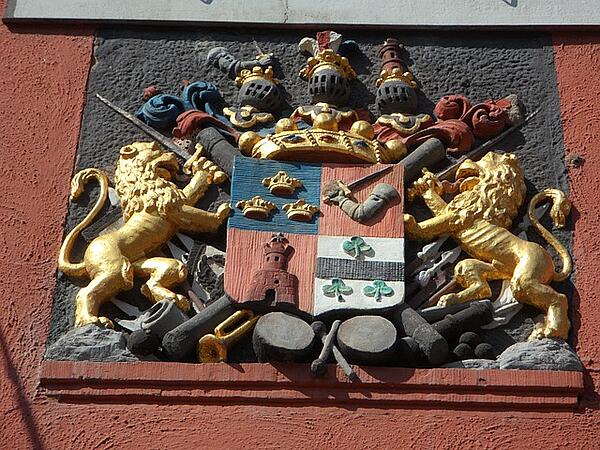Coats of Arms
In Medieval England, knight’s were identified during battles and tournaments by their coat of arms.
There are very detailed rules about how a coat of arms could be made up, including well-defined rules about which colours could be used.
The simplest part being the achievement. In terms of heraldry, an achievement was the complete display of crest, arms and accessories made up of eight parts.
These eight parts included:
- The shield: A shield was the most important part of a coat of arms, so much so that it could appear without any other part of an achievement in many cases
- The helmet: The helmet was placed above the shield, symbolising the owner’s rank, while the mantling was draped from the top of the shield around it’s sides.
- The mantling: The mantling was draped from the top of the shield around it’s sides. This mantling was believed to be similar to the mantle that was worn by crusader knights while travelling across the Middle East.
- The wreath: The wreath was a piece of silk used in a coat of arms to cover the joint of the helmet
- The crest: the crest symbolised an object that was originally worn by knights during jousting and other tournaments.
- The supporters: The supporter refers to either an animal or a person who would appear to be holding up the shield from the sides.
- The coronets: These were only for the achievements of higher ranking people, such as dukes, earls or barons, and symbolised the rank they held.
- The mottoes: A motto would usually be written into a scroll, either at the top or the bottom of the shield.

In terms of colouring, there were specific rules for each part of the achievement, but the shield was subject to the strictest formalities. Each shield would be composed of tinctures, metals, colours and furs. The tinctures would either be metal - gold (or) or silver (argent) - or they would be coloured. Colours included blue (azure), green (vert), red (gules), purple (purpure) or black (sable). Furs could appear ermine (white spots on black), ermines (black spots on white) or hair (black and silver). The rules also stated that no colour should appear with another colour, and no metal on another metal.
The shields were designed based on patterns called ordinaries, which were bands that would go across a shield horizontally, vertically or diagonally. Ordinaries are believed to have originated from the practise of using a band of metal to strengthen a shield ahead of a battle. Shields were also split into three sections: in chief was the top section, in fess was the middle section and in base was the lower section.
Each of these band styles had its own name, including the chief or fess with a horizontal bar, and a pale with a vertical bar. Most ordinaries were simply shaped, but the more complex came to be known as sub ordinaries.
While knights of the realm would boast a helmet above their shield, peers of the realm would have a specific type of crown to represent their rank. For a baron, this would be a crown with silver spheres, while earls would have strawberry leaves with silver spheres above. A marquess would be represented by alternating strawberry leaves and silver spheres.
The description of a coat of arms was known as blazoning, while the painting of the coat of arms was known as emblazoning. The eldest member of the family would be the one to inherit the coat of arms, while younger family members would have the same with a different symbol in the centre. This tradition was known as cadency, while the tradition of a female only child merging her coat of arms with her husband’s upon marriage was known as marshalling.
See also:
MLA Citation/Reference
"Coats of Arms". HistoryLearning.com. 2026. Web.
